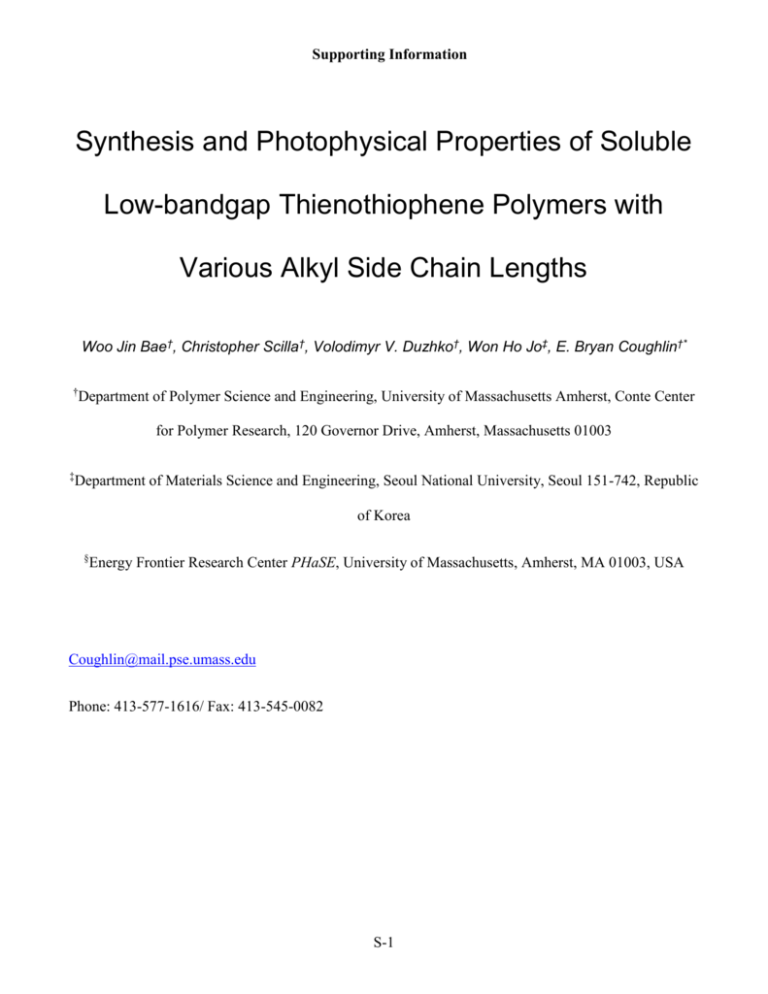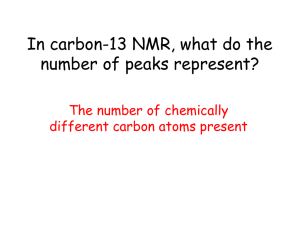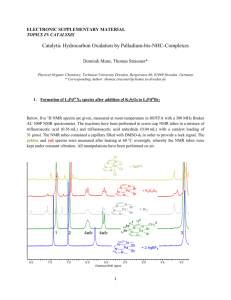Template for Electronic Submission to ACS Journals
advertisement

Supporting Information Synthesis and Photophysical Properties of Soluble Low-bandgap Thienothiophene Polymers with Various Alkyl Side Chain Lengths Woo Jin Bae†, Christopher Scilla†, Volodimyr V. Duzhko†, Won Ho Jo‡, E. Bryan Coughlin†* † Department of Polymer Science and Engineering, University of Massachusetts Amherst, Conte Center for Polymer Research, 120 Governor Drive, Amherst, Massachusetts 01003 ‡ Department of Materials Science and Engineering, Seoul National University, Seoul 151-742, Republic of Korea § Energy Frontier Research Center PHaSE, University of Massachusetts, Amherst, MA 01003, USA Coughlin@mail.pse.umass.edu Phone: 413-577-1616/ Fax: 413-545-0082 S-1 Supporting Information We should note here that after polymerization, the ring protons at = 6.61 ppm in the 1H NMR spectra of Ttx monomers look shifted and overlapped with CHCl3 peaks. Although it was previously reported that the proton peak of thienothiophene ring is shifted to 6.64 ppm upon polymerization,18 we were not able to observe any proton peak around 6.64 ppm. For the clear evidence of thiophene ring protons, 1 H NMR spectra of PTtx was obtained in CD2Cl2 to prevent the proton peaks in thienothiophene ring from overlapping with the solvent peak. As shown in Figure 1S(a) and 1S(b), the proton peak around 7.0 ppm was observed without any discernible peak at around 6.64 ppm in both polymers (PTt8 and PTt13). More crucial evidence is the 1H NMR spectrum of low molecular weight PTt13 (Mn = 1.2 K, Ð = 1.4) (Figure 1S(c)), which exhibits two distinct proton peaks in the range of 6.9 to 7.4 ppm. As peak broadening in high molecular weight polymers often make it difficult to interpret real resonance peak position, we synthesized low molecular weight PTt13 to investigate the ring proton shift. The previous report18 didn’t contain any 1H NMR spectrum in their paper or in the supporting information. Otherwise, we found 1H NMR spectrum of poly(2-decylthieno[3,4-b]thiophene) from their thesis (in page 94, 101),23 which does not show any discernible peak around 6.64 ppm and look very similar to 1H NMR spectra of PTtx synthesized in our hands. Table 1S. Nomenclature of BrThx and Ttx BrThx (x=5,6,7,8,13) Ttx (x=5,6,7,8,13) CH2 -CH3 x-1 S S S Br S-2 CH2 -CH3 x-1 Figure 1S. 1H NMR spectra of (a) PTt8 (Mn = 5.4 K, Ð = 1.5), (b) PTt13 (Mn = 3.5 K, Ð = 1.5) and (c) PTt13 (Mn = 1.2 K, Ð = 1.4) S-3 Figure 2S. 1H and (ppm) 13 C peak assignments for (a) Tt8 and (b) Br-Tt8-Br reported in parts per million (a) (b) 7.14 Br H 95.19 110. 10 S 147.66 110. 30 H 7.14 H S 6.61 95.93 113.28 Br 153.09 138.84 S 147.02 6.48 113.50 139.62 155.04 S R H R Figure 3S. 1H NMR spectra of (a) BrTh5, (b) BrTh6, (c) BrTh7, (d) BrTh8 and (e) BrTh13. S-4 S-5 Figure 4S. 1H NMR spectra of (a) Tt5, (b) Tt6, (c) Tt7, (d) Tt8 and (e) Tt13. S-6 S-7 Figure 5S. 1H NMR spectra of (a) Br-Tt5-Br, (b) Br-Tt6-Br, (c) Br-Tt7-Br, (d) Br-Tt8-Br and (e) BrTt13-Br. S-8 S-9 Figure 6S. 1H NMR spectra of (a) PTt5, (b) PT6t, (c) PTt7, (d) PTt8 and (e) PTt13. S-10 Figure 7S. FTIR spectra of (a) PTtx-O and (b) PTtx-G (a) (b) PTt5-G Transmittance (A.U.) Transmittance (A.U.) PTt5-O PTt6-O PTt7-O PTt8-O PTt13-O 3000 2500 2000 1500 1000 500 PTt6-G PTt7-G PTt8-G 3000 -1 1500 wavenumber (cm-1) Wavenumber (cm ) Table 2S. FTIR peak assignments for PTtx cm-1 Assignments 2955 CH3 asymmetry stretching 2923, 2852 CH2 in and out of phase mode 1553, 1480 C=C ring-stretching (Ttx) 1450 CH2 bending 815 C-H out of phase bending (Ttx) 734 C-S-C stretching S-11 1000 500 Figure 8S. GPC traces of PTtx’s synthesized by (a) oxidative polymerization (CHCl3, PS standard) and (b) GRIM polymerization (THF, PS dtandard) (b) (a) PTt13 PTt8 PTt7 PTt6 PTt5 Intensity (A.U.) Intensity (A.U.) PTt8 PTt7 PTt6 PTt5 5 10 15 20 25 16 Elution Time (min) 18 20 22 24 Elution TIme (min) S-12 26 28 Figure 9S. 1 H NMR spectra of 4,6-dibromo-2-alkyl-thieno[3,4-b]thiophene (Br-Ttx-Br) after magnesium halogen exchange with isopropylmagnesium chloride (iPr-MgCl) S-13 Figure 10S. Dynamic light scattering of PTtx-O(1 mg/5 ml of CHCl3). Measurement was done after filtering through 0.25 m syringe filter. 25 PTt5-O PTt6-O PTt8-O PTt13-O 20 Volume (%) 15 10 5 0 1 10 100 1000 Diameter (nm) Figure 11S. TGA thermogram of (a) PTtx-O and (b) PTtx-G (a) (b) 120 120 PTt5-O PTt6-O PTt7-O PTt8-O PTt13-O 100 100 Residue (wt%) Residue (wt%) 80 60 40 PTt5-G PTt6-G PTt7-G PTt8-G 80 60 40 20 20 0 0 200 400 600 0 800 0 o 200 400 600 o Temperature ( C) Temperature ( C) S-14 800 Figure 12S. 1st derivative TGA thermogram of (a) PTtx-O and (b) PTtx-G (b) (a) 0.8 5 PTt5-O PTt6-O PTt7-O PTt8-O PTt13-O 4 Derivative Weight (A.U.) Derivative Weight (A.U.) 0.6 PTt5-G PTt6-G PTt7-G PTt8-G 0.4 0.2 0.0 3 2 1 0 -0.2 -1 0 200 400 600 800 200 Temperature (oC) 400 600 800 Temperature (oC) Table 3S. UPS and CV results of P3HT as an internal reference UPS Sample P3HTc a E1 (eV) E2 (eV) 14.47 -1.8 (E1-21.2 eV)a (eV) -6.73 CV HOMO (eV) LUMO (eV) HOMO (eV) -4.93 -3.02 -5.13 Ekin, csynthesized by GRIM polymerization method, Mn = 20 K, Ð = 1.13 S-15 Bandgap (eV) 2.11







